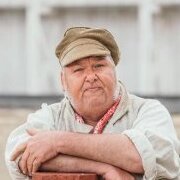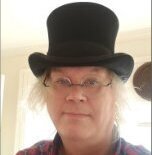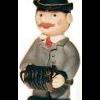-
Posts
1,139 -
Joined
-
Last visited
Profile Information
-
Gender
Male
-
Location
Land of Aloha
Recent Profile Visitors
7,201 profile views
gcoover's Achievements

Heavyweight Boxer (5/6)
-

Report: Tokyo meet-up with Gary Coover
gcoover replied to gtotani's topic in General Concertina Discussion
Hey Paul, so sorry to have missed you! Or perhaps we passed in the street or in the Shibuya Crossing unawares. It would have been great to meet you in person, and you would have loved meeting all the wonderful Japanese concertina players that Totani-san rounded up. I suppose we'll just have to schedule it for next year... Gary -

Report: Tokyo meet-up with Gary Coover
gcoover replied to gtotani's topic in General Concertina Discussion
Having just returned home, I can now officially thank Totani-san for organizing such a fantastic first-ever meeting of many of Japan's top concertina players in Tokyo on April 7 - himself, Kato, Takayuki, Goisagi, Kana, Ryoko, Akane, Aya, Tomoyuki, Gene, Aguarypko, and Ushiro (hope I remembered them all). I've known of many of them from their YouTube performances over the years, and it was quite an honor to be able to meet them in person. What a wonderful group of players, and what amazing Japanese hospitality. Totani booked a karaoke room ("world's first concertina karaoke?") in the Ochanomizu area for the group to meet in, and it lasted so long we had to move and reconvene in another room. Gene brought a 360-degree camera and hopefully I can share some of those photos of the group with everyone here on CNET. Totani later took us to Taniguchi Gakki (English Taniguchi-Gakki / 谷口楽器 since 1935), the local Tokyo shop that specializes in accordions and concertinas, where I was able to meet with owner Hiroshi Iwata through an interpreter (since I only know about 5 Japanese words). They also sell an ingenious button number/note overlay developed by Toru Kato that can be attached to Bastari concertinas to help beginners learn the notes. At the shop I also found the 116-page, 70+ tune, English Chromatic Concertina tutor written by Miyuki Miura in 2021. She has recorded 4 CD's of concertina music, and the book looks to be very well done and comprehensive, with single notes and harmonies, and with graphics showing which buttons to play for 48-button tenor, 30-button soprano, and 48-button soprano instruments. She is Gene's concertina teacher, so hopefully he can help me reach out to her about also publishing it in the English language. One of the attendees, Hayahiro Ushiro, is also an amazing manga artist, and we're already talking about doing an Anglo concertina book in Japanese (and English) that will feature many of his drawings. The meet-up was such great fun for all, I do hope they make it an annual event. And if so, I will definitely have to work up some Japanese tunes for next year. And did I mention the cherry blossoms just happened to be in full bloom all over Tokyo at the same time? I'm not sure how Totani managed that, but it was very impressive. To all the players, and especially Totani - Otsukaresamadeshita! Gary P.S. Although unable to attend, Totani reached out to Yuka Nakafuji of Tricolor who was able to confirm the name of the "Japanese Polka" in Easy Anglo 1-2-3. It is known in Japanese sessions as the "Nishijima Polka" since a fiddler named Nishijima first brought it to Tokyo. Yuka said it was originally called "Ray's Classic" - a reel written by Shetland fiddler Willie Hunter in 1975 in honor of his good friend Ray Leask's Ford Consul Classic car. You can hear "The Nishijima Polka" here (the video I nicked it from) at about the 4:15 mark: -
An update many years later... I have just returned from Singapore where I found a very friendly Irish Session in the back room of Molly Malone's Irish Pub in the wonderful River Walk area on Tuesday evenings. A fairly young group of about 7 players from a mix of nationalities, mostly Irish reels and jigs, but they also played Angelina Baker and a couple of songs including a lovely version of Ralph McTell's "Streets of London". Also, Guinness and Kilkenny on tap. There had formerly been a concertina player at the session, but I was the only one this evening, along with flutes, tin whistle, fiddle, guitar, mandolin, Northumbrian pipes, and ukulele. They were very curious how the EC and Anglo worked, and several asked for a quick 5-minute lesson which they picked up on very quickly. So, next trip, I'm hoping there will be some new concertina players! Gary
-
I believe all the tunes are now completed, but I haven't seen them yet for a final proofreading. Dan is finishing up the historical portion, which will focus more on Kimber's early years and musical backgrounds. The current plan is to have an official launch sometime in September in Headington Quarry. Of course, the Headington Quarry Morris will be there, and Andy Turner will be part of it since he is now the Headington Quarry Morris musician, and other players like John Kirkpatrick, John Watcham, and Cohen Braithwaite-Kilcoyne have also expressed interest in being part of the festivities, so it might end up being quite the event. Gary
-
Dan Worrall's House Dance is also in paperback with QR links to the audio files, available through Red Cow Music, McNeela Music, and Amazon. Gary
-
Bonjour Bastien! I would suggest left hand #6 on the push which keeps the phrase nice and smooth, but if that's too much of a reach you can do button #2 on the pull. Best of luck on the arrangement and playing at the wedding. Bon chance, mes ami! Gary
-

Push pull change while on the same button
gcoover replied to latzenpratz's topic in Teaching and Learning
Good advice from Steve and Andy - it's all about the musical effect you are looking for. As for me, I play those three notes in your example with the button held down and just snap the bellows to change direction since it's a Morris tune and the push-pull effect is part of what can give the tune some extra bounce. If you feel like playing it smoother and more legato, then you could play that second G with the left hand 4a button (if you have a 30-button Anglo) and then everything would be on the pull. Lots of choices on the Anglo. As for those who are confused about the notation, the line above the notes (and the staff) is what indicates a pull. A longer line helps with phrasing and air control by indicating longer passages of either push or pull. There is no need to show a line for notes below the staff since it just adds to the clutter, but more importantly since you can't push and pull at the same time! Gary -
Just barely in time for St. Patrick's Day, the long-awaited 75 More Irish Session Tunes for Anglo Concertina is finally out in paperback and Kindle! With regular music notation and the same button number tab system as the previous session tune book (and other Rollston Press books), but this time every tune has the benefit of being reviewed by Irish concertina master Ernestine Healy who has gone through every tune and made edits and suggestions as to how to play it in true Irish style. THE TUNES: The Ashplant, Ballydesmond Polka #2, Bank of Ireland, Bantry Bay, Behind the Haystack, Blind Mary (Mhaire Dhall), Brosna Slide, Castle Kelly, Coleraine, Concertina Reel, Cup of Tea, Dennis Murphy’s Slide, Dingle Regatta, Drops of Brandy, Farewell to Ireland, Fig for a Kiss, The Flowing Tide, Foxhunter’s Jig, Glass of Beer, Green Fields of America, Harvest Home, High Reel, Humours of Tulla, Inisheer, The Irish Mazurka, John Egan’s, Killavil Postman, Kitty’s Wedding, Little Diamond, Londonderry Air, Love Will You Marry Me, Maid in the Meadow , Maid of Mount Kisco, Mairi’s Wedding, Minstrel Boy, Miss Monaghan, Morning Dew, Murroe Polka, Music in the Glen, Musical Priest, Ned of the Hill, O’Keefe’s Slide, Off to California, Old Concertina Reel, Old Torn Petticoat, The Orphan, Over the Moor to Maggie, Paddy Fahey’s #1, Parnell’s March, Pigeon on the Gate, Planxty Charles Coote, Planxty Irwin, Rakes of Kildare, Rakish Paddy, Riding on a Load of Hay, Saddle the Pony, The Scholar, Ship in Full Sail, Ships Are Sailing, Silver Spire, Sixpenny Money, Smash the Windows, South Wind, St. Anne’s Reel, Star Above the Garter, Star of Munster, Swallowtail Jig, Swallowtail Reel, Swinging on a Gate, Tenpenny Bit, Terry Teahan’s, Tobin’s Favorite, Tom Sullivan’s Polka, Top of Cork Road (Father O’Flynn), Trip to Sligo, Walsh’s Hornpipe. It's currently available from Red Cow Music (UK), McNeela Music (Ireland), and Amazon. Since Ernestine is originally from County Mayo, attached is a sample from the book: "Rakes of Kildare" which likely came from Westport in County Mayo. Gary Rakes-of-Kildare-75MIST.pdf
-

Crook Concertinas - And my recent experience looking for a good instrument
gcoover replied to tangbo's topic in Buy & Sell
Also Frank Edgley in Canada, very high quality hybrid and traditional Anglos. Not exactly sure what Wally Carroll will be doing next, but his work is also top notch. Gary- 25 replies
-
- crook concertinas
- makers
-
(and 3 more)
Tagged with:
-
Kurt was a regular at the Old Pal Concertina Weekend from the very beginning, and we always enjoyed his old time favorites played exquisitely on a large Crane Duet. I last talked with him only three months ago about a problem he was having with one of his reeds and he sounded quite well. His humor and musicianship were a huge part of the Old Pal event and he will be greatly missed. Next weekend will be the 20th anniversary of concertinas at the Old Palestine Festival - we shall have to come up with a suitably musical memorial in his honor. We love you, Kurt, now you can make the angels smile with all your great tunes! Gary PS - Here's a photo of Kurt from the 2005 Old Pal Festival.
-

Rollston Press at Old Pal Concertina Weekend
gcoover posted a topic in General Concertina Discussion
Just wanted to let everyone know who might be thinking of attending the Old Palestine Concertina Weekend in East Texas this next week, March 21-23, (oldpalmusic.com) - all of the Rollston Press concertina books there will be available for the enticing special festival price of only $10 each. Chris Droney's daughter and Frank Edgley will both be playing and teaching there, so I'm sure they would be willing to sign their books. Dan Worrall will also be there. Gary Coover (who dat?) will be there too, perhaps the lone voice of harmonic-style Anglo playing amongst all the ITM! Hope to see some of you there, enjoying good music, good friends, craft beer, and of course, good East Texas BBQ. Gary -
My trusty worker, Jeff Bezos, says they should be available in the next 72 hours. Gary
-
Unfortunately not - Alan used a different button numbering system for his Twenty Button Anglo from 2004. This new tunebook uses the same "1a-10" numbering system that is in the other Rollston Press books. Gary













